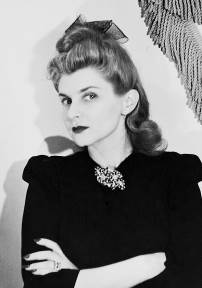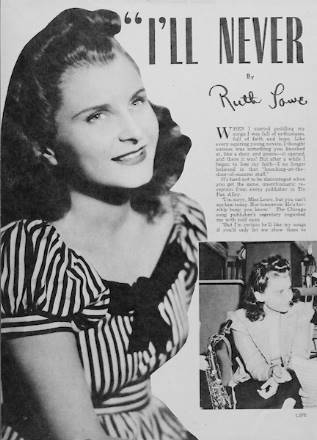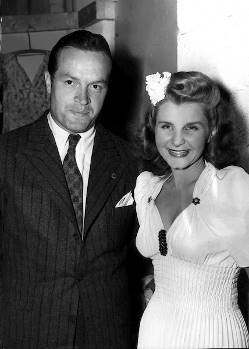
“Dorsey was a great marketer,” explains James Kaplan. “Once he saw how ‘I’ll Never Smile Again’ was taking off, with sales of records and sheet music, he brought Ruth to New York City and made sure her story became known.”

Figure 20: Ruth
Ruth Lowe was famous, no doubt about it. And following the release of ”I’ll Never Smile Again,” her life changed dramatically. People wanted to know all about the young lass who had written this wonderful song and the story behind its creation. She made a number of public appearances and quickly rose to fame in the music industry. Soon, she was being interviewed by newspaper and magazine columnists, she was featured on radio shows and even began making public appearances wherever people wanted to see the girl who’d written “the song.” One such appearance saw her being part of comedian Red Skelton’s vaudeville show. And she had a less than stellar moment when she tripped over the bolted down shoes used by a comedian to “lean over” into the audience: Ruthie ended up in the lap of someone in the first row, laughing her head off.
By now, Miss Lowe was getting huge amounts of fan mail to add to her acclaim. Everyone wanted her picture. It was quickly getting to the point where she couldn’t handle all the hoopla on her own.
“So, she calls up to Toronto from New York,” Mickey says. “And she pleads with me, ‘I need you to come down here. Right away. You’ll be my secretary.’“
Mickey pauses, looks out the window, recalling the thrill of the times.
“Now I ask you, who’s going to say no to that?”
The Lowe sisters took up residence at the Astor Hotel in Times Square. It was right across the street from where Frank Sinatra was appearing at the Paramount Theatre with the Pied Pipers.
“We’d see and meet many of the great stars who came to play the Paramount,” says Mickey. “But Sinatra was special. You know, he was a proud New Jersey boy who would often refer to his hometown of Hoboken, and it struck me then that he was one whose success seemed to come simply because he was so good at what he did. Even to hear his songs today, especially one of Ruth’s songs, I still get teary eyed.”
After one of his shows, Sinatra came back to their room.
“Ruthie asked him to say hi to me,” Mickey recalls. “Well, I just about died.”
Having been introduced to the thrilling world of celebrities and talented artists who she’d grown up only dreaming about, Mickey now joined Ruth in her outings to the famed Tin Pan Alley offices of music publishers where she’d play the new tunes she’d written.

Figure 21: From Ruth's scrapbook
And the entrepreneur in Ruth Lowe—perhaps passed on by the spirit of her father, although with more adherence to success—got to work capitalizing on her éclat. She and Sair Lee soon developed a weekly radio show for NBC where the two would play the songs of the day, singing and kibitzing throughout. They were known as “The Shadows” and Tom Sandler has a recording of one of their shows that begins, “Howdy neighbour, you’re listening to The Blue Network, NBC.”
“I used to get such a kick out of Sair’s name,” Tom recalls. “Sair Lee. Just like a Sara Lee banana cake, one of my faves to this day! Oh, by the way, before I forget, mom made a killer banana cream pie!”
Ruth also wrote “The Lowe Down,” a jazz column read widely in New York and elsewhere. And to fill in her quiet hours (not!), she happened to manage the Murray Room, a New York jazz night club.
And you wonder why she needed her sister’s help!

Figure 22 Ruth with Bob Hope
“Ruth even got me a job at a music store in New York,” Mickey says.” And she brought our mother down to live with us. Now I have to say, for our mother, it was trying. She had no friends or family in that great big city. But for me? A fabulous time in my life! And Ruthie, no matter how different our lives were or wherever her success took her, she was always there for me. A strong, giving sister, so full of life.”
Propelled by her remarkable talent and spurred on by the tune that was becoming so beloved, Ruth Lowe had entered a glamorous world of famous stages and celebrated entertainers. Her acquaintances ranged from Sinatra and Dorsey, to Duke Ellington, to Sammy Cahn, to Ed Sullivan, to Henny Youngman, to Milton Berle, to Bob Hope, to Danny Kaye, to Vic Damone, to Buddy Rich, to Al Jolson, to... and on and on. She even introduced fellow Canadian, Jack Duffy, to Tommy Dorsey and he ended up singing with TD for a while. The fact that Duffy bore a slight resemblance to Sinatra didn’t hurt.
And then, there was “The Happy Gang,” a hugely popular Canadian Broadcasting Corp. lunchtime variety radio show that ran from 1937 to 1959 with about two million listeners a day. A mention there, on the CBC, could pay off big time, and with the Gang supporting Ruth and her song, this only added to her zest.
Most importantly, Ruth Lowe was gaining a reputation as one of the architects of the American Ballad.
Never one to sit still for long, Ruthie itched to write more songs. Sometimes on her own, more than often collaborating with the gang from the Brill building, she wrote “Too Beautiful to Last” with Marty Symes, created for the 1941 MGM film Ziegfeld Girl with James Stewart and Judy Garland. And “My First Love,” which she penned with Mack David. And “My Love Came Back to Me” with George Fragos, famous for his hit “I Hear A Rhapsody,” and several others. In fact, in September 1940, when Dorsey and his orchestra returned to Toronto for another Canadian National Exhibition performance, he not only played “I’ll Never Smile Again” but, caught up with the enthusiastic reception of Ruth Lowe returning to her hometown for this engagement, he featured “My Next Romance” and “Funny Little Pedro,” two of her new songs.
Now, being as active as she was, Ruth wasn’t terribly surprised one day in 1943 when she got a phone call from Sinatra. What ensued was a conversation like this...
“Hey, doll, I need you to write me a song.”
“A song, Frankie?” Ruth questions. “What kind of song?”
“Gonna be my theme song,” Sinatra explains with pride. You can practically see him puffing out his chest. After all, by now, he’s left the Dorsey organization and struck out on his own as a solo performer. “I hope you fall on your ass” is the send-off he gets from Mr. Dorsey, none too happy to see his meal ticket vanishing.
“CBS is giving me a radio show,” Sinatra explains to Ruth, “I need a tune I can be known for. You know Ruthie, something I can sing at the beginning or end of each show that will be my signature tune. Got it?”
“OK, Frankie. Now, what are you thinking of for the mood?”
“The mood? Hmmm. The mood. Well, I’m thinking it’s something that will be pretty…I dunno…something about...maybe...maybe sweet dreams? The show’s at night, so you know, Ruthie...like maybe I sing this at the end of each show and it’s like you’d say ‘Sweet dreams” to someone as they fall off to sleep. But I don’t know, Ruth...you’ll come up with something.”
“OK Frankie. Leave this with me. I’ll play around with it and get back to you with some ideas. When do you need this for?”
“Um... See, that’s the problem.”
“The problem?”
“Yeah. See, we need it for tomorrow.”
“What!?”
“Yeah. Sorry ’bout that. They just laid this on me, and the first show’s tomorrow night.”
“Frankie! I... ... mean...tomorrow night! I can’t…”
“Ruthie, you told me you wrote ‘I’ll Never Smile Again’ in one evening. You can do this. You’re so good at this.”
“But, Frank, that was totally different. I mean…”
“Look, I gotta go. So many things we need to work on for this show. There’s just no time. Anyway, you’ll nail this, I just know you will. Call me tomorrow morning. OK, Ruthie?”
“Yeah. Sure Frankie. Sure. I’ll call you tomorrow...”
Click.
Well, truth be told, Ruth had created her signature tune “I’ll Never Smile Again” in an evening. But, as she’d tried to explain to the irrepressible Sinatra, that was different. That was a song that poured from her heart because of anguish. A song that had been building within her for months and months and finally needed to break through the emotional dam and get out.
But now, a theme song for the hottest singer in the land? A signature tune that would be heard by millions of people? Every week? For...like...forever?
And it had to be composed in less than 24 hours?
Impossible.
Unless...
Following in the trail of headliners, like Irving Berlin and Cole Porter, who famously wrote both the lyrics and the music when most Tin Pan Alley tunesmiths created songs in duos, Ruth had created the melody and words for “I’ll Never Smile Again” on her own. She’d even said to an interviewer, “George and Ira Gershwin, Rodgers and Hart, Johnny Mercer and Harold Arlen, yes, I’m aware that many tunes have been created by song writing duos. And I understand that, especially when you’re turning out a bunch of songs for the next Broadway show or Hollywood movie. But that’s not me. I’m not a song writing machine and don’t want to be. I’m just a girl who writes songs when I feel like it. When I’m inspired to do so. And that’s something I can do on my own.”
But with the clock ticking, it’s definitely time for Plan B.
So, Ruth places a call to two song writing buddies, Paul Mann and Stephan Weiss. Now, these lads have been collaborating on creating lovely lilts like “They Say” and “Angel in Disguise” as well as novelty tunes such as “The Woodchuck Song” (featuring the ebullient lyric, “How much wood would a woodchuck chuck if a woodchuck could chuck wood?”).
“You guys got a tune lying around you’re not doing anything with?” Ruth asks on the phone.
There is laugher. “Hey Ruthie, good to hear from you. What kind of a question is that? Whadyamean do we have a tune lying around?”
Ruth explains the predicament she’s facing. She knows that these two guys are always batting out melodies, sometimes adding lyrics and trying to peddle new tunes. And sometimes, when the song doesn’t quite click, the tune or the lyrics go on the shelf, awaiting inspiration for a future date.
Ruth just hopes today’s shelf might feature a lovely tune looking for words. You know, one that would do as a theme song for the most in-demand vocalist in the country. You know, by tomorrow.
“24 hours!” They respond with laughter after hearing her story. “You’re kidding, right? Frankie Sinatra needs his theme song by tomorrow!?”
But Ruth tells them it’s no joke.
And as chance would have it, turns out the boys do have a tune they’ve been playing with. Not fully finished, mind you, but part way there.
“My father was a fabulous piano player,” says Lindy Kahn, daughter of the late Paul Mann who passed away in 1983. Lindy, an educational consultant, sits in the stylish home in Houston, Texas that she shares with her husband, Sanford, an attorney.
“People don’t know that about him,” she continues. “I mean, his reputation is as a song writer and, yes, he was born in Vienna and worked as a film composer in Berlin before coming to the U.S. in 1938. But he loved playing the piano. He played with flair and passion. He played in the Catskills and my mother, Yvonne—her mother was an opera singer, you know—she sang with him on stage.”
“My dad felt that rock and roll really killed composing good music,” Lindy continues. “He had bitterness about that, about not being able to continue composing good songs that the world seemed not to need anymore. It took away his motivation. He actually wanted to be a conductor. But he had to put food on the table for my mother and me and my brother, so he stopped writing songs and went back to his first love, playing the piano in clubs and restaurants. In fact, I have beautiful memories of him playing every year on my birthday. It was magical!”
“And, you know, just like Ruth Lowe, Dad hung out with Sammy Cahn and Jimmy Van Heusen and all the famous songwriters, and eventually some of these guys asked him to go to Hollywood and work for Warner Brothers. But Paul Mann was not a risk taker. He chose to stay home with my mom and my brother and me and play the piano.”
Lindy pauses and looks off. “It’s just too bad you didn’t contact me a few months ago when Mom was still alive. She could have told you so much.”
Meanwhile, the clock is ticking, and Ruth Lowe needs a song. A big song.
Paul moves to the piano while Stephan holds the phone over the soundboard. He bangs out the gist of a tune, one they’ve been playing around with. When done, he feels the need to make excuses.
“I mean, Ruth, it’s not finished. But I don’t know, I think there could be something there...”
“I like it!” Ruth gushes, feeling somewhat pleased with herself that she’s made the right call. “You know what, guys, I’ve got some words I’ve been throwing around for a song,” she tells them. “Haven’t really finished anything. But they might work with that melody...”
The three of them agree that with the partially finished tune the boys have at hand, and with Ruth’s lyrics part way there, they might just have a fighting chance to pull a rabbit from the hat.
A sleepless night transpires.
And by the crack of dawn, Ruth Lowe’s singing...
Put your dreams away for another day17
And I will take their place in your heart.
Wishing on a star never got you far
And so, it’s time to make a new start.
It’s a slow-tempo, romantic ballad with Ruth’s dream-like lyrics reminding listeners they’ll find love wherever it’s offered.
Before noon, they’ve wrapped it up. She places a call to Sinatra.
“Frankie, listen to this,” Ruth says earnestly as she places the phone on the piano and begins to play and sing the song that will serve as his signature tune for 25 years. The ballad that will be the last song played at his funeral in 1998.

Figure 23: Put Your Dreams Away
She finishes and waits breathlessly for the verdict.
“Ruthie...” Sinatra intones.
“Yes Frank,” she says. He hates it, she thinks.
“I love it. Play it again. It’s great. I knew you’d come through.”
The smile overtaking her nervous face signals to the boys: We did it!
And for the second time in her short life, Ruth Lowe has joined her star to that of the biggest talent in the land.
“I’ll never forget watching our black and white TV in the 1950s,” says Lindy Kahn. “When Frank threw that raincoat over his shoulder and walked off singing “Put Your Dreams Away” at the end of the show, well, I sure knew this was an important moment in our household.”
Sinatra’s keen sense of music knew it too. “Dear old theme song,” he intones on his Grammy-winning album, Sinatra: A Man and His Music, “I love you, old buddy.” He later praises the song for having come a long way with him—“All the way from nowhere to somewhere.”
That “somewhere,” by the way, includes Sinatra singing “Put Your Dreams Away” on his radio and television shows, often in concert, and in a number of different versions he recorded for albums. That somewhere also being an opportunity for Barry Manilow to sing the tune on his Grammy-nominated album, Manilow Sings Sinatra, and numerous cover versions recorded by the likes of Perry Como, The Hi-Lo’s, cornetist Bobby Hackett, The Nelson Riddle Orchestra, the Ray Charles Singers, The Singers Unlimited, Eileen Farrell in an arrangement by Robert Farnon, Ranee Lee, John McDermott, Gisele MacKenzie, and many others. And that “somewhere” also saw “Put Your Dreams Away” used in Stanley Kubrick’s film Lolita, and in the movie Inside Moves (1980).
“I have to tell you, it’s my favorite of all the songs mom wrote,” Tom Sandler says. “I just love the positive, evocative feeling of those words.”
In fact, more than 75 years after its first appearance, Ruth Lowe’s lovely ballad still has lasting appeal, surely the mark of a distinguished ditty that once again took the world by storm.